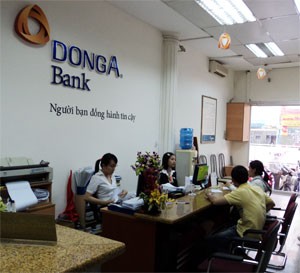Commercial banks are concern they will struggle to speed up credit growth this year as the central bank tightens the monetary policies to battle inflation.

The State Bank of Vietnam has slashed the credit growth rate target to below 20 percent from 23 percent, the lowest goal in the last five years.
The cut in the credit growth goal followed an increase in the refinancing rate on February 18 to 11 percent from 9 percent. Both policies showed the government is tightening monetary policies to contain inflation.
The government has decided to raise electricity prices by a record 15.3 percent this March and fuel prices increased on Thursday as well.
Fiachra MacCana, head of research at Ho Chi Minh City Securities Corporation, said in a statement last week that a petrol price hike would “surely push the March CPI close to or even above 2 percent month-on-month.”
The nation’s inflation rate reached 12.17 percent last month, the highest level since February 2009. The government’s target to keep inflation at or below 7 percent this year will be difficult to meet, Thoi Bao Kinh Te Vietnam newspaper reported last week, citing Nguyen Tien Thoa, the head of price control at the Ministry of Finance.
Many lenders said they increased their depositing growth target higher than the credit growth early this year due to high borrowing costs. Hanoi-based VPBank set its depositing growth rate target at 70 percent and credit growth at 40 percent.
A deputy general director of HCMC-based DongA Bank, who asked not to be named, said lenders had to pay an extra cost of 1.3-1.7 percent for deposits as they had to set aside 0.75 percent of loans as a provision against bad loans, 0.3 percent for required reserve, 0.08 percent for deposit insurance and a management fee of 0.5-0.8 percent.
“With the depositing rate of 14 percent per annum, banks have to loan at the rate of 17 percent per annum at least. Otherwise, they will surely incur losses,” he said.
However, general director Nguyen Hung of VPBank remains optimistic about the credit growth this year, saying the central bank’s slower target is adequate.
The credit growth rate of some lenders still surged to 110 percent in 2008 and 2009, when the central bank restricted the growth goal, he said.
“For example, in 2009, Maritime Bank achieved a credit growth rate of 110 percent as the state bank set the target of 25 percent only,” Hung said.
Many other banks also believed that the central bank would accept the excess of the banks, who can submit adequate plans on their credit growth over registered capital.
Do Minh Toan, deputy general director of Asia Commercial Bank, said the Circular 13 regulated that bonds were considered as loans, forcing banks to make a provision against bad loans. Thus, the credit growth was more limited, he said.
The Circular allows banks to lend up to 15 percent of their non-term deposits and have their deposits with the State Treasury counted as part of their reserves.













)

)








